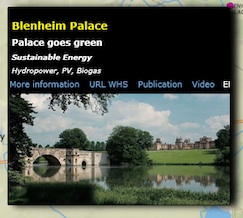World Heritage site adds hydropower to become one of Britain’s ‘greenest palaces’.
 The stately home, a World Heritage Site, will install the “Archimedean screw” design of hydropower with renewables firm Hallidays Hydropower. Fitted on the River Glyme, at Bladon Dam, the technology will be within landscape designed by architect Lancelot “Capability” Brown.
The stately home, a World Heritage Site, will install the “Archimedean screw” design of hydropower with renewables firm Hallidays Hydropower. Fitted on the River Glyme, at Bladon Dam, the technology will be within landscape designed by architect Lancelot “Capability” Brown.
The scheme at Blenheim Palace, which was the birthplace of Winston Churchill, is expected to have a lifespan of 40 years. Subsidies for electricity generated from small-scale renewables, known as feed-in tariffs, will provide an estimated £12,600 a year for the scheme, over the first 20 years.
Blenheim Palace has earned a strong reputation for its pioneering commitment to sustainability, but this high profile endorsement of British design and engineering is indicative of a bigger trend towards ‘micro hydro’.
The technology is winning attention and investment from landowners, businesses and communities across Britain, generating income through the country’s renewables incentive scheme, and saving costs in the face of continuing energy price rises and CO2 reductions.
Blenheim Palace has a dedicated team of staff implementing ongoing sustainability projects to reduce pollution, emissions and waste, reduce the use of energy, water and other resources, and encourage environmental awareness amongst staff and visitors. The Estate”s current sustainability action plan includes investigating woodchip boilers for the visitor cafe and greenhouses at the Pleasure Gardens, and replacing the old steam ship boilers at the Palace with efficient modern gas condensing boilers. A total waste audit has determined ways to improve waste management, including sending all food waste to a local anaerobic digester to produce energy for local homes.
Blenheim has already installed solar electricity (PV) panels and 40 ground and air source heat pumps for heating across its buildings. There are also plans for two biomass boilers.
Fish-friendly
There are also plans for two biomass boilers and a second hydropower scheme in 2014. The Archimedean screw turns as falling water from the top of the dam flows through it, activating a turbine and generating power. It is considered to be “fish-friendly” and have a low impact on the river. A side stream is also being developed to help fish navigate the dam, improve spawning grounds and improve the habitat.
Hallidays Hydropower has developed a technology that works “in harmony” with the landscape “at the same time enhancing the local habitat and environment”.
For further information, please visit www.hallidayshydropower.com
Blenheim Palace















